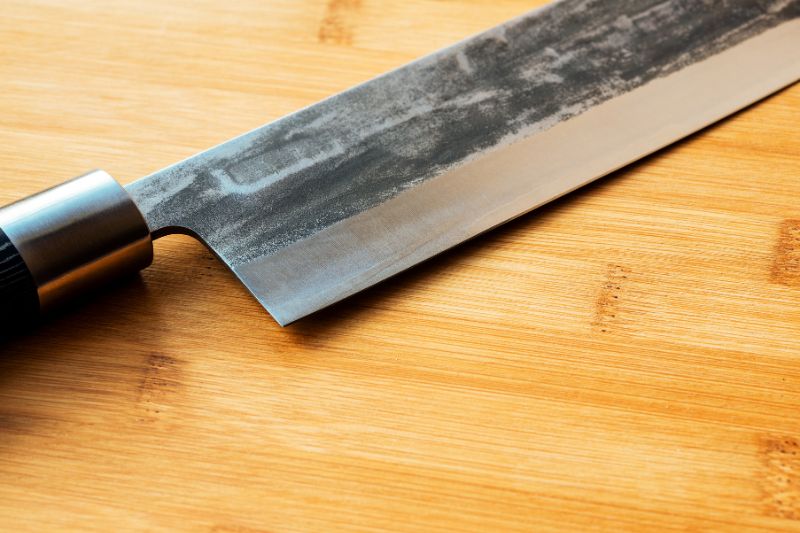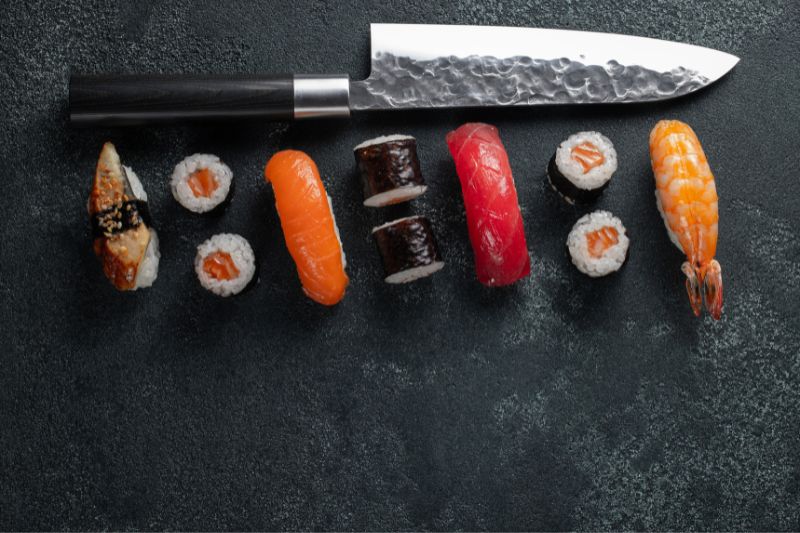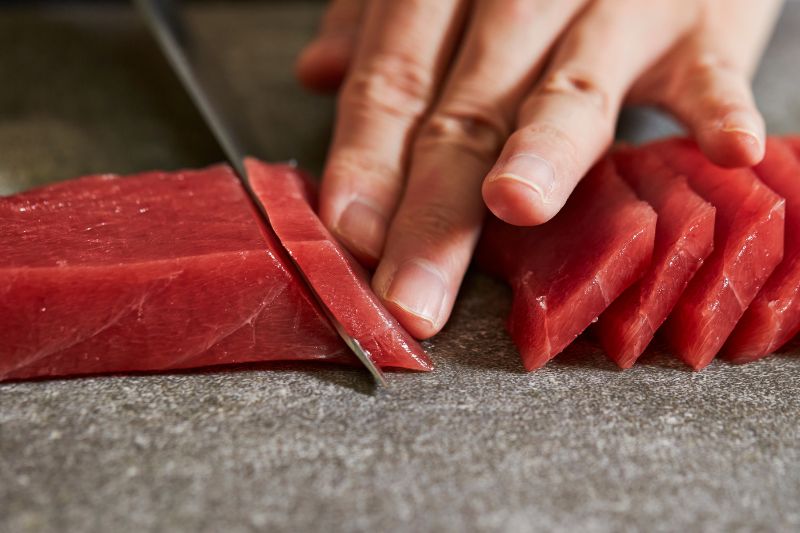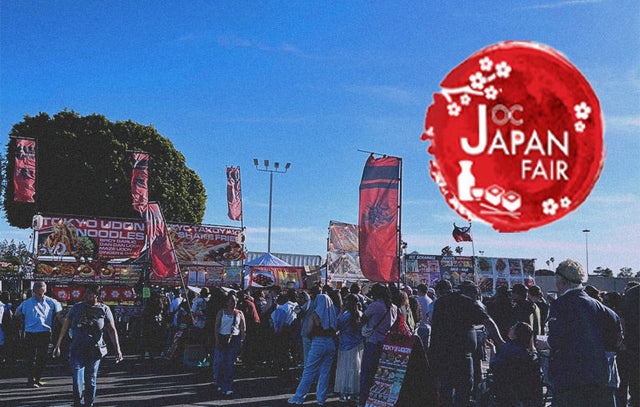One of my favorite things to do when I miss Japan and Japanese food is to go to my favorite sushi restaurant, where a Japanese chef makes Sushi right in front of the customers. I have been there many times, but the way the Sushi chef uses his knife to slice through the fish never ceases to amaze me.
As I sit at the counter, the Sushi chef quietly takes out his Yanagiba knife and regards it for a moment with respect. it feels as if the chef and his knife have a secret bond based on team spirit and years of artistry that is unbeknownst to the rest of the world. The warm light from the ceiling reflects on the long, narrow blade of the knife, creating an otherworldly aura around it. Then the sushi chef starts to slice through the fish filets - the precision, the speed, the focus, and the way it looks so effortless, as if the knife is beautifully dancing and slicing through the fish. It is an indescribable spectacle that you can only sit there and watch in awe.
I visited this Sushi restaurant a few days ago and had a long and immersive talk with the chef about the history of Japanese knives. He quoted Masaharu Morimoto, a famous Japanese chef,
"Japanese chefs believe our soul goes into our knives once we start using them. You wouldn't put your soul in a dishwasher!"
Just like he said, Japanese knives are the heart and soul of Japanese cuisine. The art of cutting is an indispensable part of Japanese culinary arts. Japanese chefs have to spend years perfecting their skills of not only using Japanese knives but also maintaining them, respecting and caring for them as they deserve. A Japanese knife is just a tool but a treasured possession of a person, often bearing the owner's initials, representing the pride one holds in his craft. The relationship between a chef and a Japanese knife is similar to that between a Samurai and his sword.
By this point, you might be having mind-boggling questions about the history of Japanese knives,
"Where did they come from?"
"Are they related to Samurai swords?"
"Why are they so important in Japanese culture?"
and so on. Based on my knowledge, research, and personal conversation with the knowledgeable sushi chef, I would like to answer all your questions about the history of Japanese knives.
A Legendary Story Between a Master Bladesmith and His Student
Before we go into the history of Japanese kitchen knives, I would like to share a legendary story that shows the teachings of Zen Buddhism and the heart and soul behind the art of Japanese kitchen knives.
During the Kamakura period in Japan, there lived a master swordsmith called Goro Nyudou Masamune, who was considered Japan’s greatest bladesmith. He had a student named Muramasa, who also became a great swordsmith, establishing his school of swordmaking.
One day while Muramasa was still a student under Masamune, he challenged his master Masamune to a test to see who makes a finer sword.
The master and the student worked day and night, and when their swords were ready, they took them to a small creek. The test was that they would put their sword in the stream, against the currents, and see whose sword cut could cut through everything that flowed down the creek.
The student, Muramasa’s sword with the title “10,000 Cold Nights”, cut through everything that flowed through the blade - leaves, fish, and even the air around it seemed to be cut by the blade. Master Masamune was impressed by his student’s sword and lowered his blade down the creek to see how well his sword performed. However, the master’s sword only cut through the leaves that flowed through it, not the fish. The student was proud of his sword’s seemingly better performance than his master’s sword. However, a Buddhist monk who was watching the whole thing came up to them and explained what happened:
“The first sword was by all means a fine sword. However, it is an evil blade and is thirsty for blood. It does not distinguish between what or who to cut. It could be cutting heads as well as butterflies. Compared to it, the second sword is the finer sword because it does not cut the ones that are innocent and undeserving.”
So through this story, we can see that a sword or a kitchen knife is not just a tool for cutting. Instead, a good knife or a sword has to have the right intention, soul, and heart behind it.
The Origin of the Japanese Word for Knives - “Houchou. (庖丁)”
If you have ever been to a Japanese knife shop, you might have noticed that in Japanese, the name of the knives ends with the suffix “bocho.” For example, Usuba-bocho (professional vegetable cutting knife), Sashimi-bocho( professional raw seafood cutting knife), and Deba-bocho (pointed carving knife).
The suffix “bocho” is a modified version of “Houchou” (庖丁) - the Japanese word for cooking knife. As you can see, this word is made up of two parts - Hou (庖) and Chou (丁).
If we trace back the roots of the Japanese word for knife, we must time travel back to ancient China, around 2000 years from now. This period in China was called the Three Kingdoms Period in China, and there lived a royal official named Wen Hui. As was common in the old times, important officials like Wen Hui had the best chefs in the country to prepare meals in the royal kitchen. In Chinese, the word for kitchen is ( 庖 ), the first part of the Japanese word for knife. The second part of the word, (丁), was the word used in China to describe an adult professional working in his professional field. So basically, combining (庖) and (丁) meant an adult male working in the kitchen as a professional chef. But how did the word for professional chef become the word for a knife? It was all due to a legendary chef who worked in Wen Hui’s kitchen, Pao Ding.
Pao Ding’s knife-handling skills, combined with his excellent culinary skills, made him very popular, and he used to call his knife ( 庖丁刀 ), which translates to “a sword used by an adult kitchen worker”. This word for kitchen knife became popularized in China by Pao Ding, and it also traveled to Japan.
However, knives were not called Houchou in early Japan. From the Nara period to the early Heian period, kitchen knives were simply called “Katana” (刀), a sword. From the late Heian period ( 794 to 1185), the word ( 庖丁刀 “Houchou Gatana” ) traveled to Japan from China, and it started to be used to describe a kitchen knife. Over time, the letter for sword ( 刀 ) was dropped for simplicity, and the word for a knife in modern Japanese is Houchou ( 庖丁 ).
Interestingly, in China, a kitchen knife is not called a ( 庖丁 ) anymore. Instead, there is a different word for it, even though it originated in China. Therefore, this word for a knife is a unique word used only in Japanese.
Chunks of Stones - The Earliest Form of Japanese Knives?
Cutting things using tools originated in the Paleolithic Era in prehistoric Japan. It is believed that people of prehistoric times in Japan made "chipped stone tools" by crushing larger pieces of stones to hunt, skin, and cut meat.
After that, human beings started polishing the chipped stones to make "polished stone tools"; thus, the stone tools evolved through the Neolithic Age.

During the Bronze and Metal Age, humans learned to harness metal and use metals as cutlery.
In prehistoric Japan, ironware began to be used alongside stoneware during the Kofun era (300 to 538 AD).
There is a puzzling archaeological fact about Japan's earliest form of knives. Let's cut into (no pun intended!) the historical terminologies to understand it better. So the order of the prehistoric periods goes like this:
- Old Stone Age (Paleolithic Era): (30,000 BC - 10,000 BC) When humans first discovered the use of stones as tools and started using the most primitive forms of chipped stone tools made by crushing stones.
- Middle Stone Age (Mesolithic Era): (10,000 BC - 8,000 BC) Period of hunter-gathering and little improvements to the chipped stone tools.
- New Stone Age (Neolithic Era): (8,000 BC - 3,000 BC) Beginning of settled human life and use of "polished stone tools."
Whereas "Polished Stone tools" did not appear until the New Stone Age in the rest of the world, archaeologists were perplexed when "polished stone tools" dating back 30,000 years were discovered in Japan!
Because of this striking finding, the Japanese Paleolithic period in Japan does not precisely match the standard definition of the Paleolithic Era based on stone technology. So this is quite a mind-boggling fact that prehistoric Japanese people were quite advanced when it came to cutting tools compared to the rest of the world.

How Japanese Knives Evolved Over Time
Click here or on the image to enlarge
- Nara Period (710 to 794)
Japan’s oldest surviving kitchen knives, resembling modern Japanese knives, are from the Nara period. Ten of these knives are preserved in
Shosoin (the treasure house of Todaiji Temple) in Nara as historical and cultural treasures of Japan.
During the Nara period, these kitchen knives were made under the rule of Emperor Shoumu.
The unique feature of the Nara period knives is that they are very similar in shape to Japanese swords (Katana), with very long handles. They were 38 to 41 cm long.
- Heian Period (794 to 1185)
During the Heian period, Japanese kitchen knives became a symbol of social status, and they started to be regarded as a possession of pride and luxury instead of ordinary tools. One of the catalysts that significantly contributed to the prestige of artisan kitchen knives was the introduction of “Houchou - Shiki” or “Knife ceremony.”
This ritualistic religious ceremony was introduced during the Heian period, and it is still possible to experience it at Takabe Shrine (a Shinto shrine dedicated to the deity of cuisine and cooking), located in Minamiboso town of Chiba prefecture.
During this ceremony, a knife maker performs a ritual that involves preparing food ingredients in front of the Emperor using only knives and chopsticks while maintaining a strict rule that the person handling the blade cannot touch the food ingredient while preparing them. The knife maker is dressed in a unique traditional Japanese attire and sits with a large cutting board in front of him, where the food ingredients are placed. He holds the chopsticks in his right hand and the knife in his left. This performance requires extreme knife-handling skills and years of practice.Through this tradition, knife-making, cooking, cutting, slicing, etc., and the use of knives rose to have cultural, religious, and historical significance during the Heian era.
According to the words of food historian and chef Hideo Dekura,
“Appreciation of food forms the foundations of honcho-Shiki. Each and every beautiful, meaningful motion of the ritual shows respect toward food; and the detailed, thorough cuts of the knife are symbolic of the mentality to waste nothing.I believe this philosophy has been passed through the 1,300 years leading to the present and is reflected in the spirit behind modern Japanese cooking.”
- Kamakura Period (1185 – 1333)
Kamakura period is known for the rise of the Samurai, the warrior caste, and Japan saw a massive and dramatic transformation in politics, culture, and society.
As the Samurai clan rose to power, things used by Samurai, such as swords, and consequently the blacksmiths, who made the swords for the Samurai warriors and rulers, became more important in society.
Furthermore, the craft of sword-making has transferred to the art of knife-making in the later years, so the history of sword-making in Japan is an essential aspect of the evolution of Japanese knives.
- Seki - a city that emerged during the Kamakura Period
Seki city, located in Gifu prefecture, is a city that is known as the center of Japanese cutlery in modern times. In the modern days, Seki is one of the “3 S cities of cutlery - Seki (Japan), Solingen (Germany), and Sheffield (England).”
Seki is a city abundantly blessed with natural ingredients necessary for forging top-quality cutlery, such as clear water from mountain springs, pine charcoal, rich iron sand deposits, and two important rivers, Nagara and Tsubo, that allow shipping infrastructure. All these qualities attracted a master swordsmith called Motoshige, known as the founder of swords in Japan, and inspired him to move to Seki (around 1229-1261) and establish a sword-smithing community in the area. The Samurai warriors of the Kamakura period praised the Seki blade as “Doesn’t bend, doesn’t break, cuts well.”
Gorō Nyūdō Masamune - A Master bladesmith known as the greatest in Japan who lived during the Kamakura Period
Masamune, from the Kamakura era, is known as Japan’s greatest bladesmith. He is known to have perfected the art of “Nie,” a term describing the shining of steel crystals in the Pearlite matrix, which resembled the stars in a night sky. However, this was very difficult at that time because the steel available for sword-making was often contaminated with impurities.
The most famous sword made by Masamune is the “Honjo Masamune.” This sword was a symbolic sword for the Tokugawa Shogunate throughout the Edo period, a prestigious family treasure that would be passed down from one Shogun to the other.
- Muromachi Period (1336 to 1573)
The Muromachi period was one of the most violent periods in Japanese history, marked by feudal wars and political turbulence. Yet, despite this instability, this historical period witnessed tremendous cultural growth. The traditional Japanese arts, such as tea ceremonies, Ikebana (flower arrangement), ink painting, etc., flourished under the influence of Zen Buddhism.
Japanese cuisine formats were also developed during the Muromachi period. As a result, different schools of Japanese cuisine emerged during this time. During this period, Japanese knives started to be called the current Japanese word for kitchen knives - “Houchou.”
The knives used during the Muromachi period are thought to have been used exclusively for cutting vegetables (in Buddhism, it is discouraged to eat meat), and the knives had a blade with a concave shape.
- Edo Period (1603 to 1867)
The Edo period started with the end of the Sengoku (warring) period, and hence, Japan saw a period of peace, political stability, and economic and cultural growth. As a result, people more than ever enjoyed the arts, culture, and beauty of Japanese traditions.
Until the early Edo period, most kitchen knives had a shape similar to that of a Japanese sword - with a narrow, slightly curved blade, with a long handle. However, as the Edo period progressed, there was less and less need for swords as the political atmosphere became relatively stable. So the swordsmiths who made swords during the Sengoku era turned their crafts to making household blades such as kitchen knives and farming blade equipment.
Also, due to the flourishing of the art of Japanese cuisine, the tasks of chefs became more specialized, with titles such as “Houchoushi” (Master of Houchou, chefs who would cut meat and fish) and “Kizamisakanashi” (Master of dishes, chefs who would cut vegetables). Due to these changes, new and different Japanese kitchen knives appeared during the middle to late Edo Period. Some of these knives are the most famous Japanese ones that are in use today, such as Deba, Yanagiba, Usuba, and Nakiri.
- Meiji Era (1868 – 1912)
During the Meiji Restoration, Japan underwent rapid modernization and Westernization. Everything in Japan started to change during this period starting, from politics and social traditions as well as people’s eating habits.
According to Buddhist belief, eating meat, especially beef, was discouraged, and Japanese people had avoided eating meat for more than 12 centuries. However, the Emperor of the Meiji era ate beef and broke this taboo. After this, people started eating meat as well, and therefore knives specialized in cutting meat, such as Gyuutou (the Japanese version of the Western kitchen knife), appeared.
When people started eating meat, even in the typical household, it took a lot of work for ordinary house cooks to maintain different knives for specialized purposes; therefore, a knife for multiple purposes, called the Santoku knife, was created.
Another significant impact of the Meiji restoration on Japanese kitchen knives happened through “The Sword Abolishment Edict.” This was a general ban on the carrying of swords by ordinary people. This limited the creation of swords by the swordsmiths to a few pieces per year, causing the swordsmiths to turn to the making of other cutting items such as kitchen knives.
These swordsmith families who have been making swords for generations have now established the esteemed Japanese kitchen knife industry, and they are still going on strong even today, carrying the history and traditions of centuries with them.
The “City of Knives” - Sakai, a Japanese city with a History of More than 1000 years in the Craft of Knife-Making
Talking about the history of Japanese knives would be incomplete without a mention of the City of Knives - Sakai, a bustling port city in Osaka prefecture. Since medieval times, Sakai city has been one of the most important seaports in Japan, connecting the local culture to the outside world. It was the center of trade, business, as well as culture. For example, the greatest tea master of the Japanese tea ceremony, Sen No Rikyu, is known to be from Sakai City.
The oldest known record of iron-based blade-making in the areas of Sakai city dates back to the 5th century! But the knife-making industry in Sakai really took off during the 16th century when tobacco and guns started arriving from foreign countries such as Portugal. Sakai, being a port city, had good access to these products from abroad, and the forging techniques used for knife-making by the Sakai knife makers became important in the production of guns and for creating blades for cutting tobacco leaves. Today, Sakai has an incredible share of more than 98% of domestic knife production, both in the professional and home knife industry.
One of the unique features of Sakai’s knife industry is the division of labor. Knife-making is a lengthy process with more than ten steps that requires excellent craftsmanship at each stage. In Sakai, one knife is made through the teamwork of multiple craft masters' hands. The crafting of a knife can be divided into three broad steps, Forging, Hatsuke (Creating the blade), and Etsuke (Making and Attaching the handle), and each of these steps can be further divided into more than ten steps! At each step, there is a master craftsman with years of experience and generations of history working with his knowledge, passion, and expertise combined with the natural elements of Sakai, such as fire, water, and iron.
First Hand Experience of the History of Japanese Knives - Museums to Visit
If you feel like you want to know even more about the history of Japanese knives or to see some of the oldest knives in Japan and have a personal experience of walking through the history of Japanese blacksmith craftsmanship, there are several fantastic museums in Japan where your wish can be fulfilled. I will introduce some of them below:
When you walk up to the traditional Japanese-style building that houses this museum, you will see a large kitchen knife at the front of the building. This museum is an excellent place to discover the Japanese art of cutlery. The second floor of the building showcases various types of kitchen knives that have been in use since old times in Japan. Some rare types of Houchou can be seen, such as the “Maguro-bouchou” (tuna cutting blade), which is 150cm long! One of the most amazing things about the museum is that there are artisan Sakai knife makers working on-site, who will explain their craft to the visitors and show them how they work on the knives. The visitors can even purchase hand-made knives at the museum bearing the “Certified Traditional Seal.”
Address: 1 Chome-1-30 Zaimokuchonishi, Sakai Ward, Sakai, Osaka 590-0941, Japan
In Japanese, Hamono means blade, for example, knives, swords, scissors, etc. Cutlery Sanshu, was established in 1938 and has a long history of almost a century. It carries with it the teachings and traditions of Seki City’s history and culture of swordsmiths that started during the Kamakura period.
It is one of the top attractions of Gifu prefecture, and the visitors can not only look at old Japanese kitchen knives but experience firsthand how Japanese knives are made through a well-distributed division of labor. They have exciting educational facilities such as “Japanese swordsmith experience,” “Experience making a small sword from Japanese sword materials,” and “Iaikiri (a demonstrator splits a bamboo into two pieces in one go using a Seki blade).”
Address: 950-1 Oze, Seki, Gifu 501-3265, Japan
Final Words
From the hands of prehistoric human beings, in the form of chipped stones, to the hands of knife users today, Japanese knives have traveled a long way through centuries of history. However, now that more people outside Japan are starting to know the superior quality and craftsmanship behind Japanese knives, I believe the future of Japanese knives will be just as exciting as the history behind them.
Get Free Bonus Books
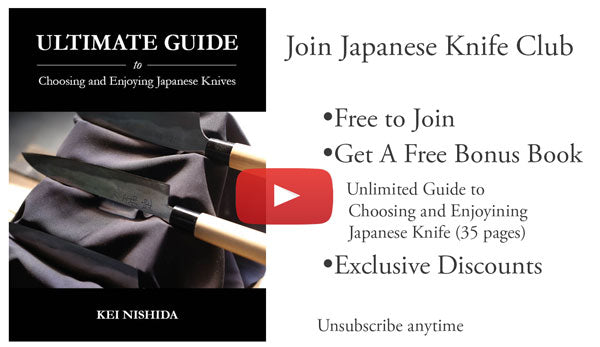
Sign up for free to the Japanese Knife Club to get advice and exclusive articles about how to choose Japanese Knives, and tips and tricks for using Japanese knives.
About the author
Kei Nishida
Author, CEO Dream of Japan
Certification: PMP, BS in Computer Science
Education: Western Washington University
Kei Nishida is a passionate advocate of Japanese craftsmanship, a writer, and the founder and CEO of Japanese Knife Co., Japanese Green Tea Co., and Japanese Coffee Co., all part of Dream of Japan.
His journey began with a mission to introduce the world to the exquisite flavors of Japanese green tea. Through Japanese Green Tea Co., he pioneered the import of premium tea grown in nutrient-rich sugarcane soil, earning multiple Global Tea Champion awards. He then expanded into the world of coffee, launching Japanese Coffee Co., the first company to bring Sumiyaki charcoal-roasted coffee to a global audience.
With a deep appreciation for Japanese artistry and tradition, Kei turned his attention to one of Japan’s most revered crafts: bladesmithing. Through Japanese Knife Co., he made handcrafted katana-style knives, created by a renowned katana maker, available outside Japan for the first time. These exceptional knives embody centuries of samurai sword-making expertise, blending tradition with modern functionality for chefs and collectors alike.
Kei’s journey continues as he uncovers and shares Japan’s hidden treasures—one sip, one blade, and one legacy at a time.



